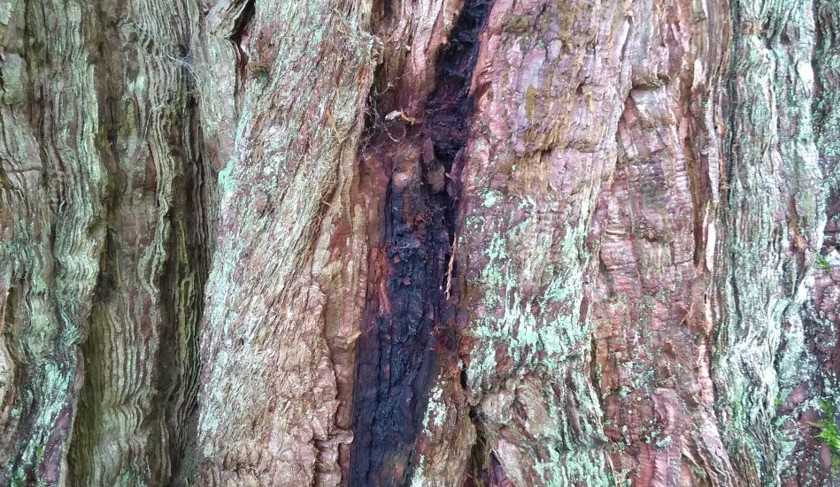Described as one of the finest entrances to a botanical garden anywhere in the world, the magnificent Redwood Avenue at Benmore Botanic Garden, on Scotland’s west coast, is in desperate need of innovative actions or risk being lost to the nation through climate change and disease.
Those caring for the historic 350m long Avenue of giant redwoods (Sequioadendron giganteum), near Dunoon, Argyll, have been monitoring increasing signs of stress. The spectre of climate change hangs over the trees and its effects are already marked. Now, the race is on to save these magnificent specimens for future generations.
Benmore is an active research and conservation site, part of the Royal Botanic Garden Edinburgh (RBGE), and the Avenue is its iconic feature. Planted in 1863 by the wealthy American James Piers Patrick, it lined the original driveway to Benmore House. These trees, native to California, were among the earliest to reach British shores when the species had only just been introduced to the outside world, making Benmore’s redwoods some of Europe’s oldest and tallest, reaching up more than 50m high.
Expressing the need for action, Benmore Curator Peter Baxter, said: “The trees are now existing, rather than growing. Their crowns are thinning and many lower branches are completely defoliated. The reasons for the decline, which has accelerated worryingly in recent years, are complex and multifaceted. Soil compaction may be central to the issue, with the Avenue having for many years provided the main vehicle access to the house. Only a very thin layer of topsoil supports the turf that now tops the original hard-core road. This, combined with a typically wet west coast climate, and limited drainage, causes serious waterlogging and puddling around the roots.”

In the wild, individuals are believed to live for three thousand years, attaining heights of over 90m at around 1,000 years old. ‘General Sherman’, widely considered the biggest tree in the world by far, measures over 24m in girth. So, as the Benmore beauties are mere teenagers, at this age they should be reaching vigorously skyward.
RBGE mycologist and plant health expert Dr Katherine Hayden explained: “The waterlogging can have dangerous consequences, both through creating a favourable habitat for pathogens, and by increasing trees’ disease-susceptibility through stress. The condition of the Benmore redwoods clearly suggests root problems.”
The situation is expected to worsen. Using models developed by the UK Met Office, Benmore is anticipated to experience both increased rainfall, especially during winter, and more intense storms resulting in more rapid ground saturation.
“It’s getting wetter, no doubt about it,” added Peter Baxter. “The last 10 years have seen four of the wettest since records began here in 1931. Rainfall is also becoming increasingly unpredictable: April 2019 was the driest since 1981 and the sixth driest on record. Alternating intense droughts and torrential rain will make life more difficult for both plants and people, intensifying soil waterlogging and compaction. Sudden large downpours are a big issue.”
A scientific approach is being taken to resolve the plight of the redwoods. With initial remedial action now in place, including a new mowing regime, and planting shrubs and ferns in the vicinity of the redwoods, more drastic change is required to step up conservation efforts.
The hope is that the answer lies in improving and accelerating soil drainage, preventing puddling and waterlogging around these delicate giants’ roots. This, in turn, should significantly reduce the “pathogen pressure” the trees currently face.
The task is far from straightforward, with a tricky balance to strike between sufficiently improving the soil and protecting the trees’ root systems during the work.
Soil analysis and other first phase testing suggests the best approach will be to employ a combination of breaking up compacted soil and applying a drainage layer of specialist growing medium to prevent future puddling. High-tech methodologies, easing compaction with compressed air should help mitigate many conditions that are unfavourable to tree health.
These remedies come at a price, particularly over such a large area of over 1.5 acres requiring decompaction. The cost of the work is estimated at over £80,000, for the initial phase and RBGE has mounted a fundraising campaign.
As Benmore enters its final month of the 2019 season, the ambition is that work should be well in-hand before the Garden welcomes visitors to the 2020 season on March 1. Anyone wishing to support the campaign can do so by donating online.
ENDS
For further information, interviews and images, please contact Shauna Hay on 0131 248 2900/07824529028
EDITOR’S NOTES:
Benmore Botanic Garden is part of the Royal Botanic Garden Edinburgh (RBGE). It sits on the A815, seven miles north of Dunoon on the Cowal Peninsula. Western Ferries sail from Gourock. It is open daily to the public from March 1 to October 31.
In its magnificent mountainside setting, Benmore is steeped in history and surrounded by dramatic scenery. The Garden’s 120 acres are home to a world-famous collection of plants from regions ranging from the Orient and the Himalaya to North and South America. In particular, it is renowned for its collection of more than 300 species of rhododendron.
The Royal Botanic Garden Edinburgh (RBGE) is a leading international research organisation delivering knowledge, education and plant conservation action around the world. In Scotland its four Gardens at Edinburgh, Benmore, Dawyck and Logan attract a million visitors each year. It operates as a Non Departmental Public Body established under the National Heritage (Scotland) Act 1985, principally funded by the Scottish Government. It is also a registered charity, managed by a Board of Trustees appointed by Ministers. Its mission is “To explore, conserve and explain the world of plants for a better future.”

